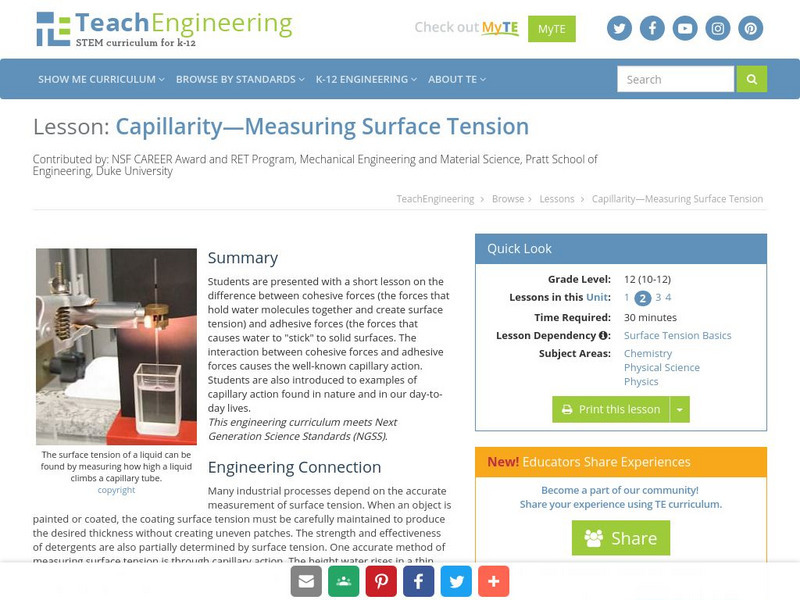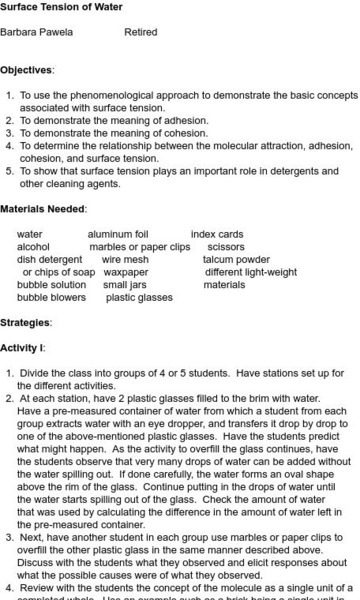Curated OER
Sewer Lice
Students observe demonstrations that show adhesion, cohesion, equilibrium density, pressure of gases and solubility. In this gases lesson plan, students observe a demonstration of raisins, spaghetti, and popcorn moving up and down in...
Curated OER
It's Just a Phase: Water as Solid, Liquid and Gas
Students construct models of the way water molecules arrange themselves in three physical states - solid, liquid, and gas. They explain the molecular behavior of ice, water, and water vapor.
Curated OER
Transport in Plants
Quite a detailed and advanced look at the transport mechanisms of a plant. The absorption and control of sugar and water concentration are explained and will help an understanding of homeostasis concepts and organ specialization.
Curated OER
How Much Do I Know About Water?
Sixth graders explore ways to analyze the properties of water and examine the chemistry of water. In this water lesson students work in groups and complete several activities.
Curated OER
States of Matter and Gas Laws
In this matter activity, students review the states of matter and the gas law formulas and equations. Students then complete 7 multiple choice questions and 6 problems.
Curated OER
Forces in Liquids
In this forces in liquids worksheet, students read their notes and answer short answer questions about forces in liquids. Students complete 6 questions total.
Curated OER
Forces In Liquids
In this science worksheet, students apply themselves to the acquisition of new vocabulary while solving the crossword puzzle.
Curated OER
The Basics of Biochemistry
Science teachers can introduce basic chemical concepts to biology students.
Khan Academy
Khan Academy: Biology: Water, Acids, and Bases: Cohesion and Adhesion of Water
This article defines and discusses cohesion and adhesion. Understand these two topics and their importance in hydrogen bonding.
CK-12 Foundation
Ck 12: Properties of Water
[Free Registration/Login may be required to access all resource tools.] Students look at the chemical structure of water and learn how it determines water's properties.
TeachEngineering
Teach Engineering: Capillarity Measuring Surface Tension
Students are presented with a short lesson on the difference between cohesive forces (the forces that hold water molecules together and create surface tension) and adhesive forces (the forces that causes water to "stick" to solid...
Science Education Resource Center at Carleton College
Serc: Investigating Water Molecules: Adhesion and Cohesion
An activity where students observe the properties of water. During this lab, students will see the nature of waters property by observing both the adhesive and cohesive properties.
TOPS Learning Systems
Tops Learning Systems: Top Science: Water Domes [Pdf]
Investigate the cohesive tension on the surface of water.
CK-12 Foundation
Ck 12: Water Properties
[Free Registration/Login may be required to access all resource tools.] In the following online tutorial students will describe the structure and polarity of a water molecule. They will also describe the hydrogen bonding that occurs in...
TeachEngineering
Teach Engineering: Surface Tension
Surface tension accounts for many of the interesting properties we associate with water. By learning about surface tension and adhesive forces, students learn why liquid jets of water break into droplets rather than staying in a...
Science and Mathematics Initiative for Learning Enhancement (SMILE)
Smile: Surface Tension
This is a laboratory exercise which demonstrates the surface tension of water.
TeachEngineering
Teach Engineering: Exploring Capillary Action
Students observe multiple examples of capillary action. First they observe the shape of a glass-water meniscus and explain its shape in terms of the adhesive attraction of the water to the glass. Then they study capillary tubes and...
US Geological Survey
Usgs: Capillary Action
Capillary is described and explained. It is related to surface tension. Examples in botany and human physiology are given.
Bill Nye
Bill Nye: Penny Droplets
This tutorial by Bill Nye introduces the concept of a cohesive force through an experiment involving a penny and droplets of soapy water.












![Tops Learning Systems: Top Science: Water Domes [Pdf] Activity Tops Learning Systems: Top Science: Water Domes [Pdf] Activity](https://static.lp.lexp.cloud/images/attachment_defaults/resource/large/FPO-knovation.png)



